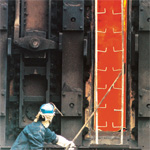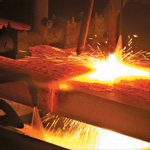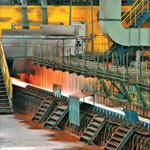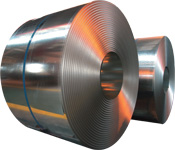 |
|
|
Phases of Modernisation
 1980-84 1980-84
Modernisation Phase I
- The plans were
implemented in a record
time of 29 months.
- Two 130 tonnes LD
converters were set up
for the first time in an
integrated steel plant in
India.
- A four-hammer Bar
Forging Machine (18,000
tonnes capacity p.a.) was
also installed.
 1985-89 1985-89
Modernisation Phase II
- A Bar and Rod mill – the first of its
kind in India - of a single strand high
speed mill was set up.
- In-house R & D efforts developed
a new technology permitting the
use of blue dust that improved the
productivity of the blast furnaces.
- Coke Ovens using environment
friendly stamp-charging technology
were introduced.
- Cost effective technology of coal
injection in blast furnaces was
implemented.
 1990-94 1990-94
Modernisation Phase III
- The highly automated G blast
furnace was installed with special
charging and distribution system.
- LD Shop 2 with 130 tonne capacity
LD vessels was set up.
- Two single stranded slab casters
were installed.
- A semi-continuous Hot Strip Mill
was introduced.
 1995-1999 1995-1999
Modernisation Phase IV
- The hot metal capacity was raised to
3 million tonnes per annum, crude steel
capacity to 3.5 mtpa and saleable steel
capacity to 3.2 mtpa.
- One ladle furnace each was added to LD1
and LD2.
- The 3rd single strand slab caster and 3rd
converter were installed.
- Continuous Casting was increased to 95%
from 65%.
- The Hot Strip Mill capacity doubled to 2
million tonnes.
 2000-2005 2000-2005
Modernisation Phase V
- IT enabled processes through
the implementation of the ERP
driven SAP and Ban systems
were introduced to break
prevalent mindsets through
Knowledge Management.
- The state-of-the-art Cold
Rolling Mill (1.2 million tonnes)
was inaugurated with output
of 800,000 tonnes of cold rolled
and annealed products and
about 400,000 tonnes of cold
rolled coated products.
TOP |
|
 |